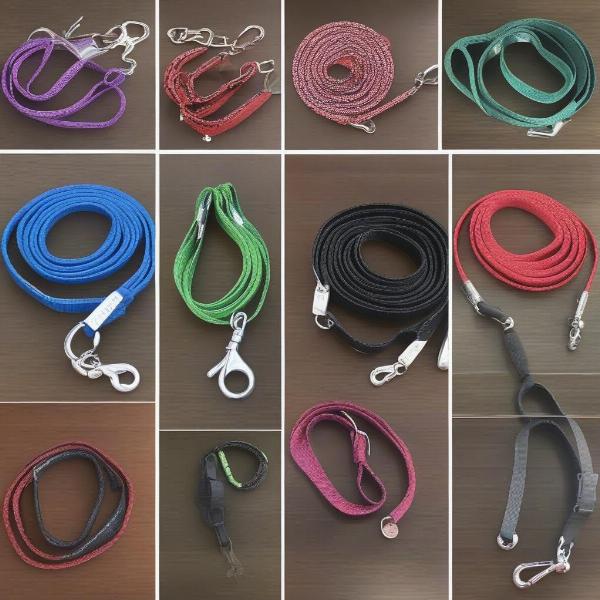Choosing the right dog lead for a large dog can be a daunting task. With so many options available, finding one that balances safety, comfort, and control is crucial. This guide dives into the essential factors to consider when selecting a dog lead for your powerful companion, ensuring enjoyable and safe walks for both of you.
Understanding Your Large Dog’s Needs
Different large dog breeds have varying temperaments, strengths, and training levels. A lead suitable for a gentle giant like a Great Dane might not be appropriate for a more energetic breed like a Rottweiler. Consider your dog’s pulling tendencies, size, and overall behavior when making your selection. For example, a dog that pulls excessively will benefit from a lead designed to distribute pressure and reduce strain on both the dog and the handler.
Types of Dog Leads for Large Dogs
Several types of leads cater to the specific needs of large dogs. Standard flat leads are a versatile option, while retractable leads offer more freedom for exploration (though caution is advised due to potential safety hazards). Chain leads offer durability and control but can be heavy and uncomfortable. For strong pullers, consider a no-pull harness or head halter combined with a sturdy lead.  Different types of dog leads for large dogs
Different types of dog leads for large dogs
Choosing the Right Material and Length
The material of the lead is just as important as the type. Leather leads are classic and durable but require regular maintenance. Nylon leads are lightweight and weather-resistant, making them a popular choice. Consider the climate and your dog’s activity level when choosing the material. The length should provide enough freedom for your dog to explore comfortably without compromising control. A lead that’s too short can restrict movement, while one that’s too long can be difficult to manage.
Handles and Hardware for Comfort and Control
The handle should be comfortable for you to grip, especially during extended walks. Padded handles can prevent chafing and provide a more secure hold. Durable hardware, like strong clasps and D-rings, is essential for safety and reliability, ensuring the lead can withstand your dog’s strength.
Training Your Large Dog with a Lead
Even with the perfect lead, training is crucial for enjoyable walks. Teach your dog to walk politely on a loose lead, rewarding good behavior and gently correcting pulling. Consistency and positive reinforcement are key to successful lead training.
What to Look for in a Dog Lead for a Large, Strong Dog?
If your large dog is a strong puller, look for a lead made from robust materials like heavy-duty nylon or reinforced leather. Consider a lead with a padded handle for added comfort and control. A shorter lead may also be beneficial for managing a strong dog, providing you with more leverage. Consider using a slip leads for large dogs or climbing rope dog lead.
What if my dog continues to pull despite the lead?
If your dog continues to pull despite using a suitable lead, consult a professional dog trainer. They can help identify the root cause of the pulling and provide personalized training techniques to address the issue. A no-pull harness or head halter can also be helpful tools for managing pulling.
Conclusion
Choosing the right dog lead for a large dog is an investment in your dog’s safety and your enjoyment of your time together. By considering your dog’s individual needs, exploring the various types and materials available, and prioritizing comfort and control, you can find the perfect lead to make every walk a positive experience. Remember, consistent training is essential for a well-behaved walking companion.
FAQ
- What is the best lead length for a large dog? A 4-6 foot lead is generally recommended for most large dogs.
- Are retractable leads safe for large dogs? Retractable leads can pose safety risks for large, strong dogs due to the potential for sudden jerks and injuries.
- How do I clean a leather dog lead? Use a leather cleaner and conditioner specifically designed for dog leads.
- What should I do if my dog’s lead breaks? Immediately secure your dog and replace the broken lead with a new, reliable one.
- Can I use a regular lead with a no-pull harness? Yes, a regular lead can be used with a no-pull harness.
- What is a british dog lead? A british style dog leash.
- Are there any specific leads recommended for training? A standard flat lead or a slip lead (slip leads for small dogs) are often recommended for training purposes.
ILM Dog is your trusted partner for comprehensive dog care and guidance. We offer expert advice on everything from breed selection to health, training, nutrition, and finding the best products for your furry friend. Whether you’re a new dog owner or a seasoned one, our global team is dedicated to providing the most reliable and practical information. For more information, consider extending dog leads for large dogs. Need personalized advice? Reach out to our team of experts at [email protected] or call us at +44 20-3965-8624. ILM Dog is here to support you on every step of your dog ownership journey.